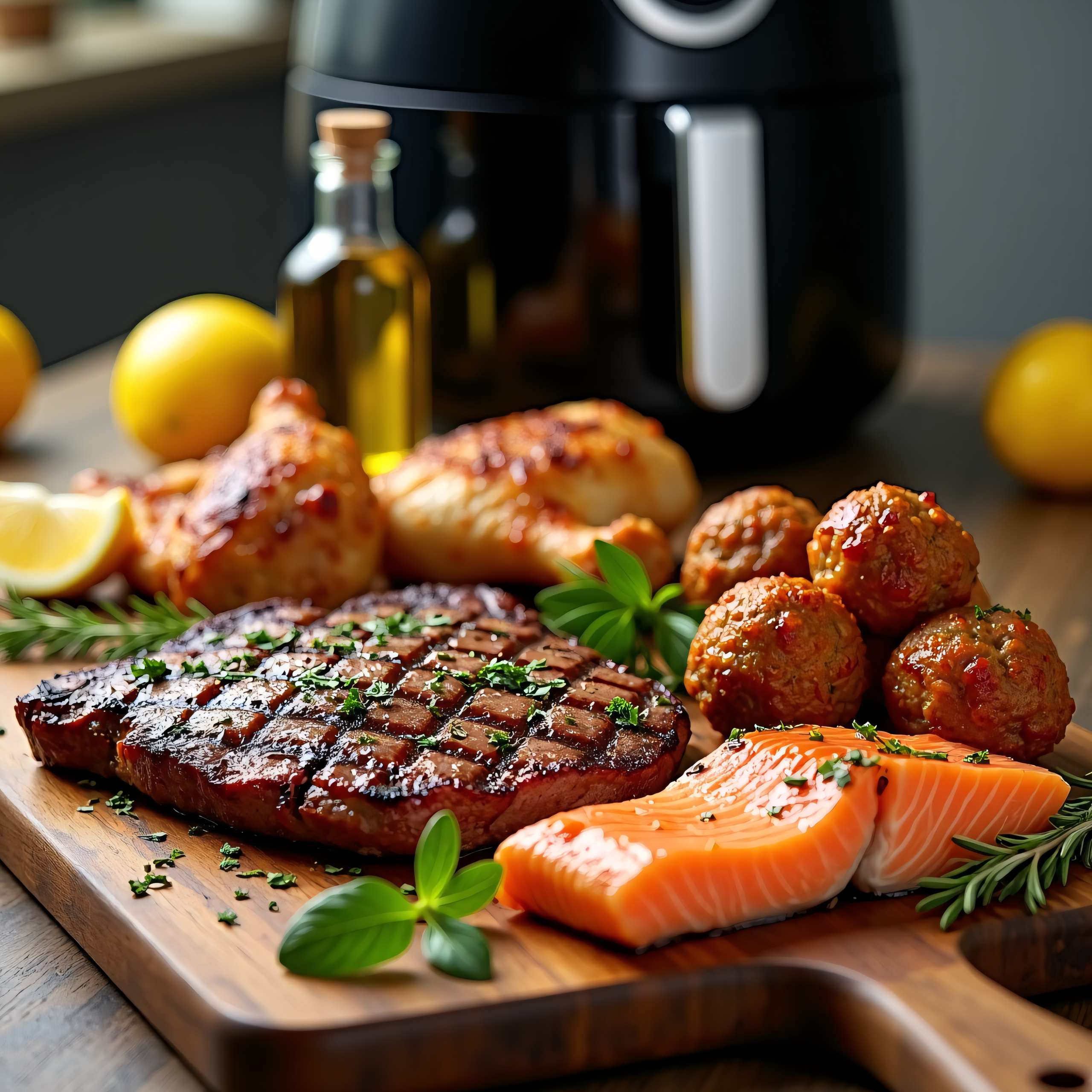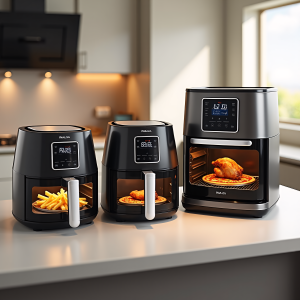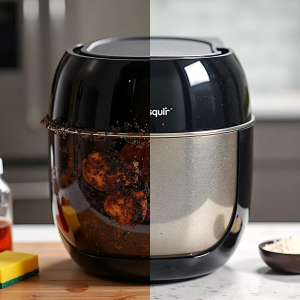estimated reading time: 8 minutes
What Is an Air Fryer? – A Deep Dive
At its core, an air fryer is a small, countertop convection oven. It uses rapid air circulation and a heating element to cook food, mimicking the results of deep frying but with significantly less oil. The technology behind air frying has its roots in steam convection, a method of cooking that utilizes both hot air and steam to cook food evenly. Over time, this technology evolved into the compact and user-friendly air fryers we know today.
Several types of air fryers exist on the market:
- Basket-style air fryers: These are the most common type, featuring a basket to hold food and a heating element at the bottom. They are generally compact and easy to use, but their capacity is limited.
- Oven-style air fryers: These larger models resemble small ovens, often with multiple cooking functions beyond air frying. They offer greater capacity and versatility, allowing you to cook larger quantities of food or experiment with different cooking methods.
- Hybrid models: These combine features from both basket-style and oven-style air fryers, providing a balance of convenience and capacity.
Regardless of the type, most air fryers share common components: a heating element to generate heat, a powerful fan to circulate hot air rapidly, and a basket or tray to hold the food.
How Does an Air Fryer Work? – The Science Behind the Crisp
The magic behind air frying lies in the combination of the Maillard reaction and convection heating. The Maillard reaction is a chemical process that occurs when amino acids and reducing sugars react at high temperatures, creating hundreds of flavor and aroma compounds responsible for the characteristic browning and delicious taste of cooked food. Air fryers achieve this through rapid air circulation, a process known as convection heating.
Convection heating differs from conventional oven heating in that it actively circulates hot air around the food using a fan. This rapid air movement ensures even cooking and browning, resulting in crispy textures similar to deep frying but without the need for submerging food in oil. Unlike deep frying, which relies on the food being submerged in hot oil, air frying uses significantly less oil – often just a tablespoon or less – to achieve crispy results. This is because the hot air circulates around the food, creating a crispy exterior while cooking the inside evenly. The temperature control within the air fryer is crucial for achieving optimal results. Precise temperature settings allow you to tailor the cooking process to different foods and desired textures. Check out our blog post Why you need an air fryer
Air Fryer vs. Deep Fryer: The Showdown
| Feature | Air Fryer | Deep Fryer |
|---|---|---|
| Oil Usage | Minimal (1-2 tsp or less) | Significant (submerging food in oil) |
| Cooking Time | Generally faster | Can be faster for some foods, slower for others |
| Health Impact | Significantly healthier | Less healthy due to high oil content |
| Taste & Texture | Similar to deep fried, but slightly different | Authentic deep-fried taste and texture |
| Convenience | Easy to use and clean | Can be messy and require more cleanup |
| Cost (unit) | Generally less expensive | Generally more expensive |
| Cost (operating) | Lower energy and oil costs | Higher energy and oil costs |
The health benefits of air frying are significant. Air frying uses dramatically less oil than deep frying, leading to a drastic reduction in fat and calorie intake. However, it’s important to note that while air frying reduces the intake of unhealthy fats, it doesn’t eliminate the potential formation of acrylamide, a chemical compound that can form in starchy foods cooked at high temperatures. Maintaining proper temperature control and cooking times can minimize acrylamide formation. The taste and texture achieved through air frying are comparable to deep frying, though some subtle differences may exist. While air frying might not perfectly replicate the texture of deep-fried food, it provides a healthier alternative that delivers a satisfyingly crispy result. Cleaning an air fryer is generally much easier than cleaning a deep fryer, as there’s less oil splatter and residue to contend with.
Air Fryer Benefits: Beyond Just Health
The advantages of air frying extend beyond its healthier profile. Its convenience is undeniable: quick preheating times and faster cooking speeds mean less time spent in the kitchen. Air fryers are incredibly versatile, capable of handling a wide range of cooking tasks beyond just frying. From roasting vegetables to baking desserts, reheating leftovers, and even dehydrating food (depending on the model), the possibilities are virtually limitless. Compared to a full-sized oven, air fryers take up significantly less counter space, making them ideal for smaller kitchens. Furthermore, the reduced risk of oil splatters and burns enhances safety during cooking. And finally, the lower oil and energy consumption contribute to cost-effectiveness.
Is Air Frying Healthy? Debunking the Myths
While air frying is generally considered a healthier alternative to deep frying, it’s not a magic bullet. One common concern is the potential formation of acrylamide. However, studies show that proper temperature control and cooking times can significantly minimize acrylamide formation. Additionally, air frying doesn’t entirely eliminate the need for oil; some oil is often used to enhance flavor and crispness. Choosing healthy oils, such as olive oil or avocado oil, is crucial. While air frying preserves more nutrients compared to some other cooking methods, it’s still important to maintain a balanced diet. Air frying is a healthier *option*, but it’s not a license to overindulge.
Air Fryer Cooking Times: A Beginner’s Guide
A good starting point for many air fryer recipes is a temperature of 400°F (200°C). However, cooking times are approximate and vary depending on the air fryer model, food type, quantity, and desired level of crispness. Always refer to specific recipes for precise cooking times. Remember to shake or flip food halfway through cooking to ensure even browning and crispness. Adjusting the cooking temperature and time is essential for different foods and thicknesses. Thicker cuts of meat or larger vegetables may require longer cooking times and lower temperatures to ensure they cook thoroughly without burning. Read more on our blog post Air Fryer Mastery: Perfectly Cooked Proteins Every Time
Source: https://airfryers.net/air-fryer-cooking-chart
Air Fryer Uses: Beyond the Basics
The versatility of an air fryer extends far beyond its namesake function. Experiment with roasting vegetables to achieve crispy, perfectly browned results. Many air fryers can even bake, allowing you to create cakes, muffins, and cookies with minor recipe adjustments. Reheating leftovers in an air fryer often produces crispier and more appealing results than microwaving. Depending on the model, some air fryers can even dehydrate fruits and vegetables to make healthy snacks, or even grill with the use of specialized accessories.
Air Frying for Beginners: Tips & Tricks for Success
Preheating your air fryer is crucial for achieving optimal results. Don’t overcrowd the basket; proper air circulation is essential for even cooking. Lightly coat your food with oil using a spray bottle or brush for crispiness. Regular cleaning and maintenance are key to keeping your air fryer in top condition. Worried about Maintenance of the Air fryer check out our blog post The Ultimate Guide to Air Fryer Cleaning & Care: Keep Your Fryer Fresh!
Conclusion
Air frying offers a convenient and relatively healthy way to enjoy crispy, delicious food. Its versatility extends far beyond frying, opening up a world of culinary possibilities. With this comprehensive guide as your starting point, you’re well-equipped to embark on your air frying journey. Explore new recipes, experiment with different ingredients, and discover the delicious potential of this versatile kitchen appliance. Read our blog post on NALSA Air fryer or PHILIPS air fryer.
FAQ
- Q: Can I cook frozen food in an air fryer? A: Yes, many frozen foods can be cooked directly in an air fryer, but adjust cooking times accordingly. Refer to the manufacturer’s instructions and specific recipes for guidance. [4]
- Q: How often should I clean my air fryer? A: After each use, wipe down the basket and tray. A more thorough cleaning (including the heating element) should be done at least once a week, or more frequently depending on usage. [5]
- Q: What kind of oil should I use in my air fryer? A: Use high-smoke-point oils like avocado oil, olive oil, or canola oil. Avoid oils with low smoke points, which can produce harmful compounds at high temperatures. [9]
- Q: Is air frying really healthier than deep frying? A: Generally yes, as it uses significantly less oil, leading to lower calorie and fat intake. However, it’s not a magic bullet for a healthy diet. [2, 3, 7, 8]
- Q: What happens if I overcrowd the air fryer basket? A: Overcrowding prevents proper air circulation, resulting in uneven cooking and potentially soggy food. Cook in batches to ensure optimal results. [1, 5]



